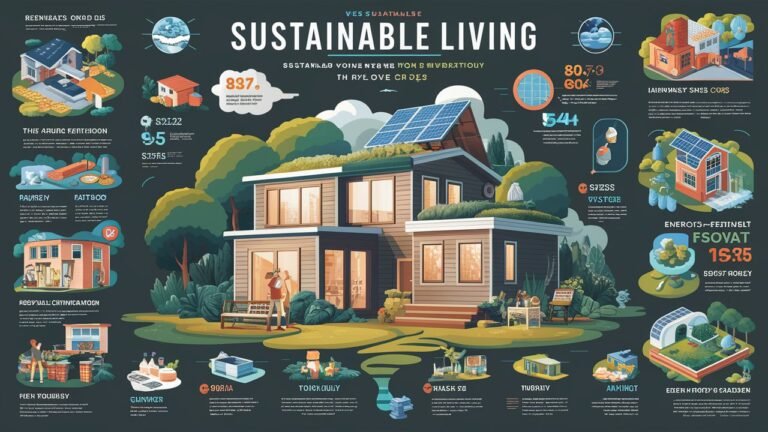In today’s world, sustainability isn’t just a buzzword—it’s a lifestyle choice that can profoundly impact our planet. Our homes, where we spend the majority of our time, are an ideal place to implement eco-friendly practices. Making your home environmentally friendly not only reduces your carbon footprint but also promotes a healthier, more efficient, and often cost-effective living space. Here’s a comprehensive guide to transforming your home into a sustainable sanctuary.
1. Optimize Energy Efficiency
Energy consumption is one of the most significant contributors to environmental impact. Reducing energy usage in your home is a simple yet effective step toward sustainability. Start by replacing traditional incandescent bulbs with energy-efficient LEDs. These bulbs use up to 80% less energy and last significantly longer.
Next, consider upgrading your appliances to ENERGY STAR-rated models. Modern appliances are designed to consume less electricity while maintaining performance. For heating and cooling, invest in a programmable thermostat to regulate temperature efficiently. Sealing windows and doors can prevent heat loss in winter and reduce cooling needs in summer, further conserving energy.
2. Embrace Renewable Energy Sources
Solar panels are no longer just a futuristic idea—they’re becoming more accessible for homeowners every day. Working with reputable solar companies in Salt Lake City can help you install panels that significantly reduce your dependence on fossil fuels while lowering your energy bills over time. If installing panels isn’t feasible, explore local programs that provide renewable energy through the grid. Even simple measures, like using solar-powered outdoor lighting, can make your home more eco-friendly.
3. Choose Sustainable Materials
When renovating or furnishing your home, the materials you choose matter. Opt for sustainably sourced wood, recycled metal, or bamboo for flooring and furniture. Bamboo, for example, grows rapidly and requires minimal water, making it an excellent eco-friendly alternative to traditional hardwood.
For paints and finishes, select low-VOC (volatile organic compounds) or VOC-free options. These reduce indoor air pollution, creating a healthier living environment for you and your family. Additionally, when possible, repurpose or upcycle old furniture instead of discarding it—this reduces waste and gives your home a unique, personalized touch.
4. Reduce Water Waste
Water conservation is critical in creating a sustainable home. Installing low-flow faucets, showerheads, and dual-flush toilets can significantly cut water usage without compromising functionality. Consider collecting rainwater for garden irrigation or indoor plants, which reduces reliance on municipal water systems. Even simple habits, like turning off taps while brushing your teeth or running full loads in dishwashers and washing machines, contribute to water savings.
5. Prioritize Indoor Air Quality
Sustainable homes aren’t just about energy efficiency—they’re also about maintaining a healthy environment. Houseplants like spider plants, peace lilies, and snake plants naturally filter toxins from the air while adding a touch of greenery.
Proper ventilation is equally important. Ensure your home has good airflow to prevent mold and indoor pollutants from accumulating. Using natural cleaning products instead of chemical-heavy options can also minimize harmful emissions indoors, keeping your living space clean and eco-conscious.
6. Implement Waste Reduction Practices
Reducing household waste is a cornerstone of sustainability. Start by establishing a robust recycling system, separating plastics, glass, and metals. Composting organic waste, such as vegetable scraps and coffee grounds, is another excellent way to cut down on landfill contributions while creating nutrient-rich soil for your garden.
Additionally, make mindful purchases. Choose products with minimal packaging, buy in bulk when possible, and consider second-hand or refurbished items. These practices reduce the demand for new materials and curb the environmental impact associated with manufacturing.
7. Create a Sustainable Outdoor Space
Your yard or balcony can also reflect your eco-conscious mindset. Plant native species, which require less water and maintenance, and avoid chemical pesticides that harm local wildlife. If space allows, a vegetable garden can supply fresh, homegrown produce, reducing reliance on store-bought items and their associated transportation footprint.
Composting garden waste and using mulch to retain soil moisture are simple steps to maintain a healthy and sustainable outdoor environment. Even small actions, like installing a drip irrigation system, can make a meaningful difference in conserving water.
8. Mindful Lifestyle Habits
Finally, sustainability at home extends beyond physical changes—it’s about lifestyle choices. Adopt habits such as turning off lights when leaving a room, unplugging electronics when not in use, and rethinking transportation options. Walking, biking, or using public transport can significantly reduce your household’s carbon footprint.
Educating family members about sustainable practices and creating an environment where eco-conscious choices are encouraged ensures that your home’s green impact is both meaningful and long-lasting.
Making your home environmentally friendly doesn’t require a complete overhaul overnight. By incorporating energy-efficient solutions, sustainable materials, water-saving measures, and mindful habits, you can transform your living space into a sustainable sanctuary. Each step, no matter how small, contributes to a healthier planet and a more balanced lifestyle. Sustainable living starts at home—and the journey is both rewarding and empowering.
